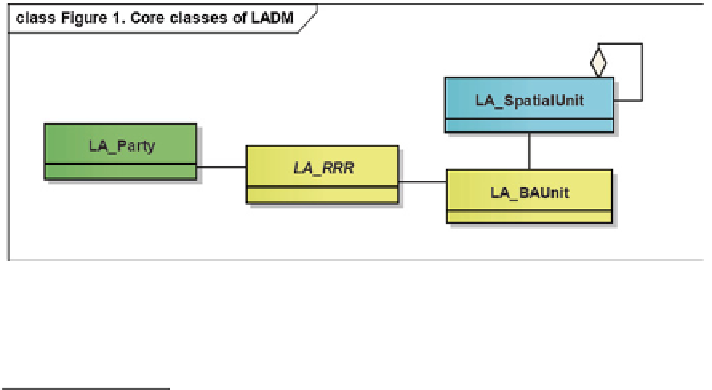Geoscience Reference
In-Depth Information
Fig. 10
LADM core classes and relationships (ISO/TC211
2012
)
Table 1
Conceptual model's entities, their definition, and corresponding LADM classes (after
Liu
2013
)
Entity name
Definition
LADM class
OWNER
A single or corporative person
LA_Party
OWNERSHIP
The ownership between the owners and building objects
LA_RRR
BUILDING
A building infrastructure object
LA_BAUnit
PART_GEOMETRY
A basic spatial 3D geometric unit
LA_SpatialUnit
• Spatial sources (e.g. surveying)
• Spatial representation (geometry and topology).
LADM is written in Unified Modelling Language (UML) and the diagram
depicted in Fig.
10
shows the core classes for LADM and their relationships,
in which there are four basic classes: LA_Party, LA_RRR, LA_BAUnit and
LA_SpatialUnit. In order to understand the model depicted in Fig.
10
, let us take
a simple example (Lemmen et al.
2010
): Oosterom, a LA_Party, has LA_RRR
ownership on LA_BAUnit Oosterom's estate consisting of two (2) LA_SpatialUnit
parcels (with same LA_RRR).
The Conceptual, Logical and Physical Models
Our 3D cadastral model aims at describing the overall relationships between
3D legal objects and owners. The conceptual model was designed based upon
the core model of LADM (Liu
2013
), and consists of four main entities: Owner,
Ownership, Basic_Building, and Part_Geometry. Their definition and correspond-
ing entities in LADM's core classes are summarised in Table
1
. Although current
Portuguese cadastral legislation does not fully support 3D ownership rights and
restrictions, a full 3D cadastral law was assumed for our study purposes.
For the time being, general entity attributes were considered for implementa-
tion test purposes. These can be extended as needed according to specific cadas-
tral laws. Figure
11
depicts the logical model in which entities were abstracted as






